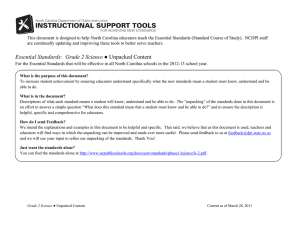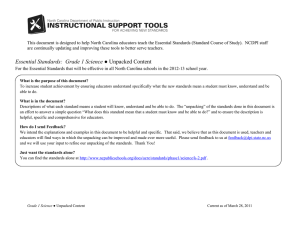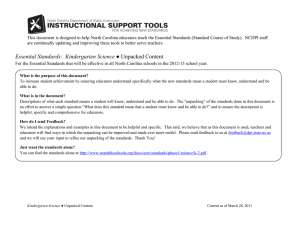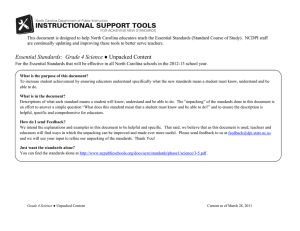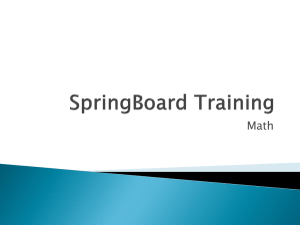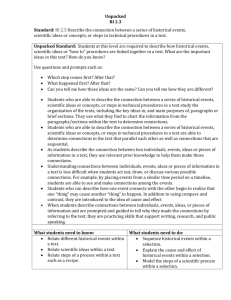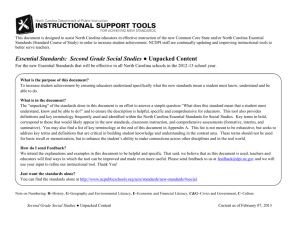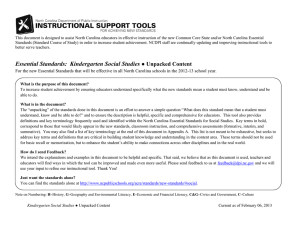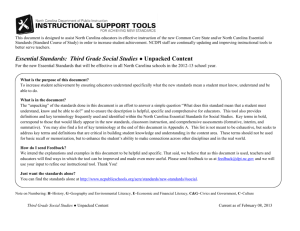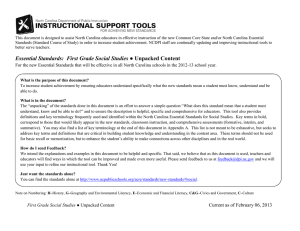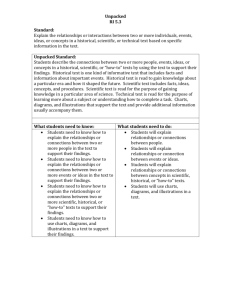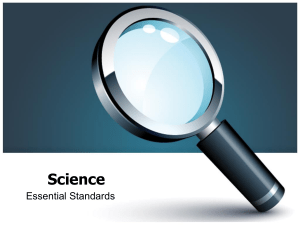Essential Standards: Grade 3 Science Unpacked Content
advertisement
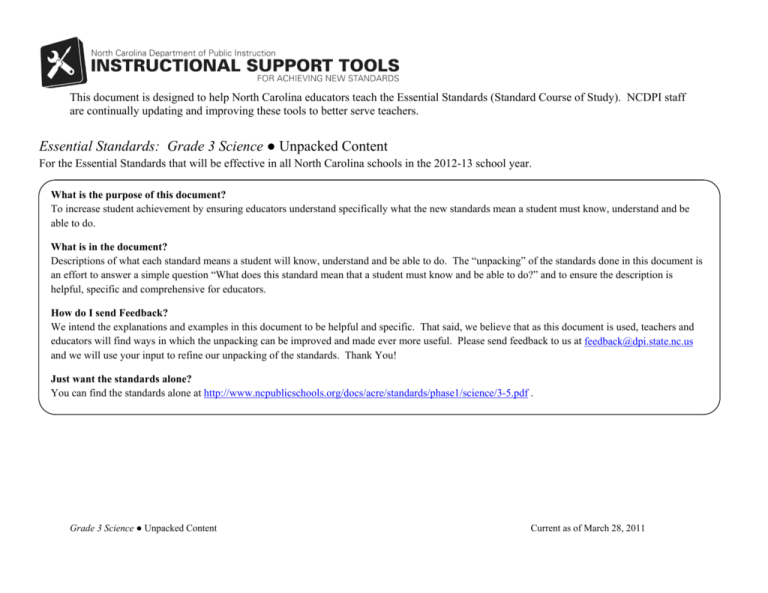
This document is designed to help North Carolina educators teach the Essential Standards (Standard Course of Study). NCDPI staff are continually updating and improving these tools to better serve teachers. Essential Standards: Grade 3 Science ● Unpacked Content For the Essential Standards that will be effective in all North Carolina schools in the 2012-13 school year. What is the purpose of this document? To increase student achievement by ensuring educators understand specifically what the new standards mean a student must know, understand and be able to do. What is in the document? Descriptions of what each standard means a student will know, understand and be able to do. The “unpacking” of the standards done in this document is an effort to answer a simple question “What does this standard mean that a student must know and be able to do?” and to ensure the description is helpful, specific and comprehensive for educators. How do I send Feedback? We intend the explanations and examples in this document to be helpful and specific. That said, we believe that as this document is used, teachers and educators will find ways in which the unpacking can be improved and made ever more useful. Please send feedback to us at feedback@dpi.state.nc.us and we will use your input to refine our unpacking of the standards. Thank You! Just want the standards alone? You can find the standards alone at http://www.ncpublicschools.org/docs/acre/standards/phase1/science/3-5.pdf . Grade 3 Science ● Unpacked Content Current as of March 28, 2011 2 Forces and Motion Essential Standard and Clarifying Objectives 3.P.1 Understand motion and factors that affect motion. 3.P.1.1 Infer changes in speed or direction resulting from forces acting on an object. 3.P.1.2 Compare the relative speeds (faster or slower) of objects that travel the same distance in different amounts of time. 3.P.1.3 Explain the effect of earth’s gravity on the motion of any object on or near the earth. Unpacking What does this standard mean a child will know, understand and be able to do? 3.P.1.1 Students know that when a force acts on an object it will result in a change of speed and / or direction. 3.P.1.2 Students know that speed can vary. Students know that varying the speed of a moving object will affect the time it takes for the object to travel a particular distance. 3.P.1.3 Students know that the earth ‘pulls’ on all objects on or near the earth without touching those objects. Grade 3 Science ● Unpacked Content Current as of March 28, 2011 3 Matter: Properties and Change Essential Standard and Clarifying Objectives 3.P.2 Understand the structure and properties of matter before and after they undergo a change. 3.P.2.1 Recognize that air is a substance that surrounds us, takes up space and has mass. 3.P.2.2 Compare solids, liquids, and gases based on their basic properties. 3.P.2.3 Summarize changes that occur to the observable properties of materials when different degrees of heat are applied to them, such as melting ice or ice cream, boiling water or an egg, or freezing water. Unpacking What does this standard mean a child will know, understand and be able to do? 3.P.2.1 Students know that air surrounds us, takes up space and has mass. 3.P.2.2 Students know that all matter exhibits properties. Students know that matter can be differentiated based on properties. Students know that gases, liquids and solids are all made up of particles, but the behaviors of these particles differ in the three states (gas, liquid, solid). Students know that solids, liquids, and gases (each) display unique properties characteristic of that particular state (phase) of matter. Students also know that the characteristics of particular states influence the functional applications of a given material. 3.P.2.3 When heat is applied to an object the particles in that object begin to vibrate more rapid. They also begin to move further apart. As the particles move further apart the object may change from one state to another (solid to liquid, liquid to gas). Students know that heating or cooling matter will alter the properties of that matter. Grade 3 Science ● Unpacked Content Current as of March 28, 2011 4 Energy: Conservation and Transfer Essential Standard and Clarifying Objectives 3.P.3 Recognize how energy can be transferred from one object to another. 3.P.3.1 Recognize that energy can be transferred from one object to another by rubbing them against each other. 3.P.3.2 Recognize that energy can be transferred from a warmer object to a cooler one by contact or at a distance and the cooler object gets warmer. Unpacking What does this standard mean a child will know, understand and be able to do? 3.P.3.1 Students know that rubbing objects together results in friction which releases heat energy. 3.P.3.2 Students know that objects can transfer energy by touching or by giving off or receiving energy waves. Heat can move from one object to another in more than one way. Convection (more commonly gasses and liquids) and conduction (more commonly solids) are best understood at this level not as vocabulary terms, but rather through effects that may be observed using everyday materials such as water, air, cooking and heating utensils. Grade 3 Science ● Unpacked Content Current as of March 28, 2011 5 Earth in the Universe Essential Standard and Clarifying Objectives 3.E.1 Recognize the major components and patterns observed in the earth/moon/sun system. 3.E.1.1 Recognize that the earth is part of a system called the solar system that includes the sun (a star), planets, and many moons and the earth is the third planet from the sun in our solar system. 3.E.1.2 Recognize that changes in the length and direction of an object’s shadow indicate the apparent changing position of the Sun during the day although the patterns of the stars in the sky, to include the Sun, stay the same. Unpacking What does this standard mean a child will know, understand and be able to do? 3.E.1.1 Students know that we live on a planet that is part of a solar system. Students know that a solar system includes a star and planets, and other objects. The planets and other objects revolve around the star. Students know that in our solar system Earth is the third planet from the sun. 3.E.1.2 Students know that the Sun and stars in the sky move in consistent patterns. Students know that shadows are created by objects blocking the light. Students know that as the Sun changes its apparent position in the sky, the shadows cast by objects will change. Students know that the Earth rotates on its axis and revolves around the Sun. Grade 3 Science ● Unpacked Content Current as of March 28, 2011 6 Earth Systems, Structures and Processes Essential Standard and Clarifying Objectives 3.E.2 Compare the structures of the Earth’s surface using models or three-dimensional diagrams. 3.E.2.1 Compare Earth’s saltwater and freshwater features (including oceans, seas, rivers, lakes, ponds, streams, and glaciers). 3.E.2.2 Compare Earth’s land features (including volcanoes, mountains, valleys, canyons, caverns, and islands) by using models, pictures, diagrams, and maps. Unpacking What does this standard mean a child will know, understand and be able to do? 3.E.2.1 Students know that there are bodies of water on the surface of the earth and that they are often named based on their characteristics and location. Some bodies of water are salty, some are ‘fresh’, some are ‘brackish’, and some are frozen in ice sheets and glaciers. Different types of organisms have developed to live in these different bodies and types of water. 3.E.2.2 Students know that the surface of the earth has many different types of physical features and that these features are named according to their structure. There are many representations for any given land feature and these possess correspondences consistent with their attributes. (models, maps, etc.). Grade 3 Science ● Unpacked Content Current as of March 28, 2011 7 Structures and Functions of Living Organisms Essential Standard and Clarifying Objectives 3.L.1 Understand human body systems and how they are essential for life: protection, movement and support. 3.L.1.1 Compare the different functions of the skeletal and muscular system. 3.L.1.2 Explain why skin is necessary for protection and for the body to remain healthy. Unpacking What does this standard mean a child will know, understand and be able to do? 3.L.1.1 Students know that the muscles and the skeleton provide a structural framework that protects and supports mobility of the human body. Students know that the skeletal system is comprised of bone. Bone is a hard material that provides support and protection to the body’s soft tissues. Students know that muscles are formed from tissues that contract and relax, producing motion. Muscles are attached to bones and initiate and regulate movement. Muscles are also found in internal organs that are responsible for essential life processes (heart, stomach, intestines). 3.L.1.2 Students know that the skin is the largest organ of the human body, that it covers and protects the human body from external conditions and forces. Students know that the skin contains nerve receptors that provide information about external conditions. Grade 3 Science ● Unpacked Content Current as of March 28, 2011 8 Ecosystems Essential Standard and Clarifying Objectives 3.L.2 Understand how plants survive in their environments. 3.L.2.1 Remember the function of the following plant structures as it relates to the survival of plants in their environments: • Roots – absorb nutrients • Stems – provide support • Leaves – synthesize food • Flowers – attract pollinators and produce seeds for reproduction. 3.L.2.2 Explain how environmental conditions determine how well plants survive and grow. 3.L.2.3 Summarize the distinct stages of the life cycle of seed plants. 3.L.2.4 Explain how the basic properties (texture and capacity to hold water) and components (sand, clay and humus) of soil determine the ability of soil to support the growth and survival of many plants. Unpacking What does this standard mean a child will know, understand and be able to do? 3.L.2.1 Students know the names and functions of major plant parts (roots, leaves, stems, flowers). Students know that plants have special parts that perform special functions in order for the plant to survive. 3.L.2.2 Students know that how well plants grow and survive is determined by a combination of environmental conditions. For example, drought conditions will tend to diminish plant health and growth. 3.L.2.3 Students know the distinct stages of the life cycle of seed plants (seed, germination, seedling, adult). Grade 3 Science ● Unpacked Content Current as of March 28, 2011 9 3.L.2.4 Students know that different soils possess different textures and capacities for the retention of water and nutrients. Students know that soil consists of different components. Students know that these characteristics of soil influence the growth and survival of plants. Grade 3 Science ● Unpacked Content Current as of March 28, 2011
